Interface Shear Test
Need and Scope:
This test is used for the determination of interface shear strength of the soil-geosynthetic system. The understanding of soil-geosynthetic interface shear strength is required in the design and stability analysis reinforced soil structures.
Concept:
The concept of interface testing is very much similar to that of direct shear test. A schematic diagram of interface testing is shows below. Lower box of direct shear apparatus may consist of soil, wood or roughened steel plate (depend on type of geosynthetic) and geosynthetic, that clamped over it. Upper box is filled with soil at desired moisture content and density. Upper box is remained fix under normal load and lower box pushed or pulled horizontally relative to upper box. The relationship of Normal stress and Shear stress at failure gives the failure envelope of the soil-geosynthetic and provide the interface shear strength parameters (interface adhesion and interface internal friction angle).

Reference: Stark et al., 2015
Interface Shear Test
Experimental Setup:
- Large direct shear test
- Dial gauge for vertical deformation measurement
- Dial gauge for horizontal deformation measurement
- Gripper plate, loading pad, loading yoke.
- Wooden block with clamp.
- Metalic temper.
- Weighing balance (15kg capacity)
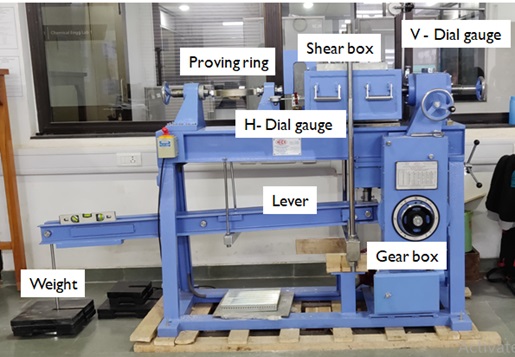

Testing procedure (ASTM D 5321M-17):
- Clamp the geosynthetic specimen over a substrate in the lower container of the direct shear apparatus without wrinkles and fold. The substrate may consist of soil (for geogrid), wooden block, and roughened steel plate.
- Bring the upper half of box into position. Weigh the soil as per required density and mixed with water uniformly. Place the soil inside the sampler in three layers. If dense sample is desired, tamp the soil with appropriate equal number of blows in each layer for the required density. Geosynthetic should not be damage during the soil compaction.
- After completing three layers, level the top layer then place the gripper plates, loading pad and loading yoke upon the soil.
- Apply the normal seating load if the test is done for the submerged condition. Allow specimen to soaked the water and monitor vertical displacement until the sample comes to equilibrium.
- For both the cases of submerged and non-submerged specimens, the desired normal load is applied and the vertical displacement is monitored until it comes to equilibrium. Verify the equilibrium is reached before shearing.
- Adjust the dial gauges and proving ring to zero position before shearing. Apply the shear force using a constant rate of displacement.
- Record the shear force and shear displacement at constant interval. Continue the test until the failure or shear force has reached the steady state.
- Repeat the procedure for two additional normal loads. Plot the test data as a graph of applied shear force versus shear displacement, shear force versus normal load and vertical displacement versus horizontal displacement.
Calibration of Normal Stress
The normal stress on specimen was applied by using lever, loading yoke and dead weight. The 94 kPa pressure was applied on the sample because of the weight of lever and loading yoke. Additionally, the known weights were applied to find the normal stress acting on the sample. Values of normal stress with applied load are shown in table below.
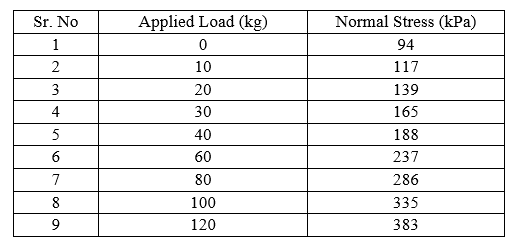
Interface Shear Test
DATA CALCULATION SHEET FOR INTERFACE SHEAR TEST
Normal stress =0.5 kg/cm2
Size of the sample = 300 mm x 300 mm x 75 mm Least count of dial gauge (Horizontal) = _______
Area of the sample (Cross Sectional) = 0.09 sq.m Least count of dial gauge (Vertical) = _______
Volume of the sample = 6750 cm3 Proving Ring No. = _ ______
Weight of the sample (gm) = _______ Proving ring constant = _______
Density of the sample (gm/cc) = _______ Normal stress (kg/ sq.cm) = _______
Water content (%) = _______ Geosynthetic type =_______
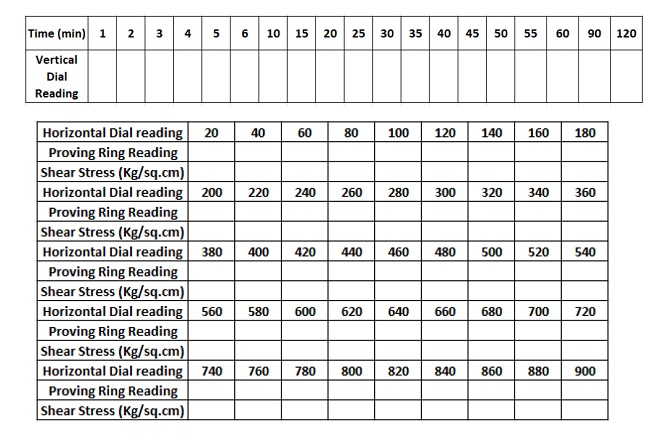
*L.C – Least Count, P.R.C – Proving Ring Constant
Water content calculation:
Name of container =
Weight of container, w1=
Weight of container and wet soil, w2 =
Weight of container and dry soil, w3 =
Water content, (%) = (w2-w3)/(w3-w1)*100
DATA CALCULATION SHEET FOR INTERFACE SHEAR TEST
Normal stress =1 kg/cm2
Size of the sample = 300 mm x 300 mm x 75 mm Least count of dial gauge (Horizontal) = _______
Area of the sample (Cross Sectional) = 0.09 sq.m Least count of dial gauge (Vertical) = _______
Volume of the sample = 6750 cm3 Proving Ring No. = _ ______
Weight of the sample (gm) = _______ Proving ring constant = _______
Density of the sample (gm/cc) = _______ Normal stress (kg/ sq.cm) = _______
Water content (%) = _______ Geosynthetic type =_______

*L.C – Least Count, P.R.C – Proving Ring Constant
Water content calculation:
Name of container =
Weight of container, w1=
Weight of container and wet soil, w2 =
Weight of container and dry soil, w3 =
Water content, (%) = (w2-w3)/(w3-w1)*100
DATA CALCULATION SHEET FOR INTERFACE SHEAR TEST
Normal stress =1.5 kg/cm2
Size of the sample = 300 mm x 300 mm x 75 mm Least count of dial gauge (Horizontal) = _______
Area of the sample (Cross Sectional) = 0.09 sq.m Least count of dial gauge (Vertical) = _______
Volume of the sample = 6750 cm3 Proving Ring No. = _ ______
Weight of the sample (gm) = _______ Proving ring constant = _______
Density of the sample (gm/cc) = _______ Normal stress (kg/ sq.cm) = _______
Water content (%) = _______ Geosynthetic type =_______
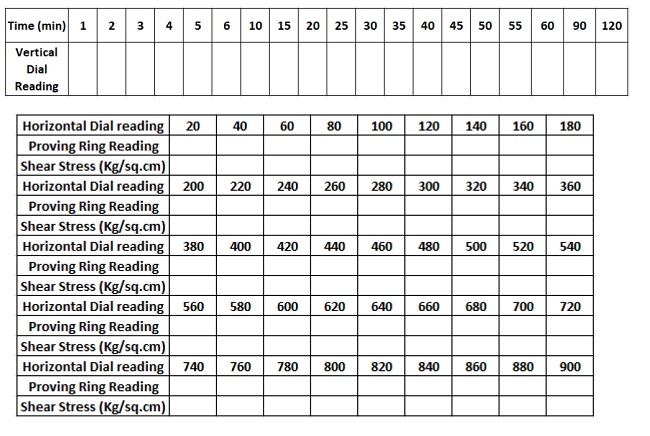
*L.C – Least Count, P.R.C – Proving Ring Constant
Water content calculation:
Name of container =
Weight of container, w1=
Weight of container and wet soil, w2 =
Weight of container and dry soil, w3 =
Water content, (%) = (w2-w3)/(w3-w1)*100
Calculations:
- Calculate the shear stress applied to the specimen for each recorded shear force as follows:
τ = Fs/Ac
Where:
τ = shear stress (kPa)
Fs= shear force (kN)
Ac= corrected area (m2)
- Calculate the corrected normal stress applied to the specimen for each recorded shear force as follows:
σN=FN/Ac
σN = normal stress (kPa)
FN= normal load(kPa)
Ac= corrected area (m2)
For tests in which the area of specimen contact decreases with increased displacement, corrected areas need to be calculated. The corrected area is calculated for each displacement reading using the following equation.
‘ Ac= A0-Ai
Where:
Ac= corrected area (m2)
A0= initial specimen contact area (m2)
Ai= contact area(m2) between specimen at each increment of shear displacement corresponding to the shear force measured at that same increment.
- No area correction required for tests in which the stationary container is larger than the traveling container as specimen contact area remain constant throughout the test.
Interface Shear Test
Graphs
- Shear stress Vs Horizontal displacement relationship.
- Shear stress Vs Normal stress (Failure envelope).
- Volumetric strain Vs horizontal strain.
Example
A interface test has been performed on cohesive soil with woven geotextile at OMC and MDD. The shear displacement rate was kept as 1 mm/min during the process of shearing. The interface testing was performed under the normal stresses of 139, 188 and 237 kPa.
Input curve: Horizontal displacement versus Time
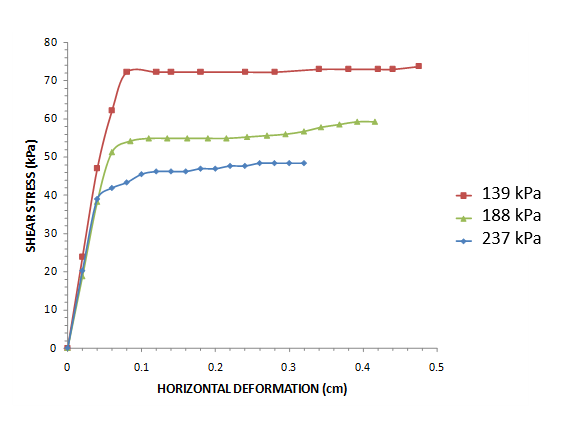
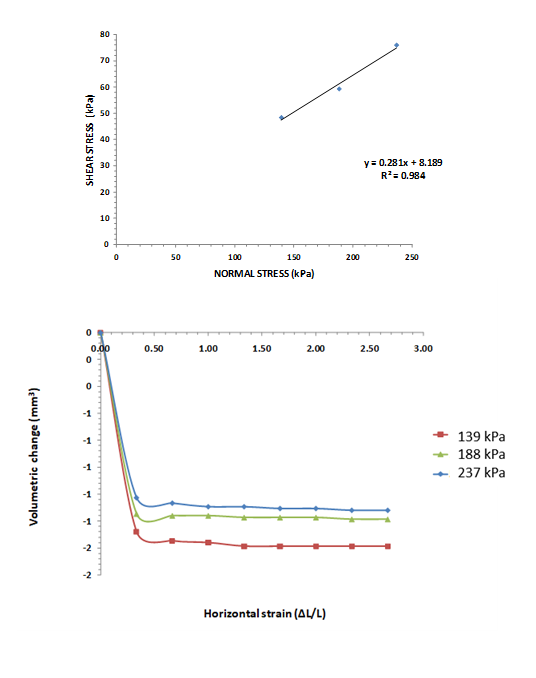
Results:
Interface friction angle = 15.7o
Interface adhesion= 8 kPa
General Remarks
- Lower substrate used in interface testing depend on geosynthetic type. For example, wooden block is used as substrate for geotextile because sagging of geotextile is not allowed during the testing. It leads to non-uniform stress distribution on geotextile. For geogrid interlocking of soil particle into the opening of geogrid play important role during shearing. Hence, soil is used as substrate in geogrid.
- Clamping is very important while interface testing and depends on geosynthetic type. Fold and wrinkles in geosynthetic should be removed during clamping.
- For soaked interface testing shear rate is depend on soil properties, geosynthetic and drainage condition. Following equation is used for determine the maximum shear rate for drained test.R= df/(50*t50*f)R = Rate of shear displacement (mm/min)
df = estimated shear displacement at peak shear stress.
t50= time required for specimen to reach 50% consolidation under the current normal stress increment.
f = factor to account for drainage conditions on the shear plane - Some standing time is allowed after the soil placing on geosynthetic and that depends on soil types i.e. for SW,SP- no requirement, SM- 3 min, SC ML CL-18 min etc.
- Volumetric change in soil depends on soil type, relative density of soil, grain size distribution of soil and type of geosynthetic i.e. woven geotextile with GC soil give contraction response, whereas geogrid with GC soil give dilation response.
Interface Shear Test
Theory:
Interface friction is a total resistance to shear between geosynthetic and soil. The total resistance is a combination of sliding, rolling and interlocking of material components.
Interface shear strength parameters are used in the design of soil-reinforced structure. Interface shear strength is important for stability analysis of the structure.
The interface shear strength properties determined by large direct shear test depends on large number of factor i.e. rate of shear, type of rigid box, density and moisture content of soil, magnitude of displacement, drainage condition, normal stress, particle size distribution of soil, stiffness and rigidity of geosynthetic material, etc.
The interface shear behavior between geosynthetic and soils is influenced by both the properties of geosynthetics and soils involved, and there are many geosynthetic products available in market. Hence, site specific testing is suggested to do the for detail design.
The possible failure mechanism in soil-reinforced structure is shows in the figure below.
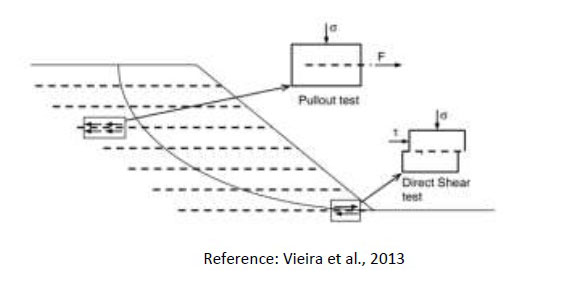
Reference:
- ASTM D5321. (2013). Standard Test Method for Determining the Shear Strength of Soil-Geosynthetic and Geosynthetic-Geosynthetic Interfaces by Direct Shear. ASTM International, 1-11.
- Vieira, C. S., Lopes, M. L., & Caldeira, L. (2013). Soil-geosynthetic interface shear strength by simple and direct shear tests. In Proceedings of the 18th international conference on soil mechanics and geotechnical engineering, Paris (pp. 3497-3500).
- Stark, T. D., Niazi, F. S., & Keuscher, T. C. (2015). Strength envelopes from single and multi geosynthetic interface tests. Geotechnical and Geological Engineering, 33(5), 1351-1367
